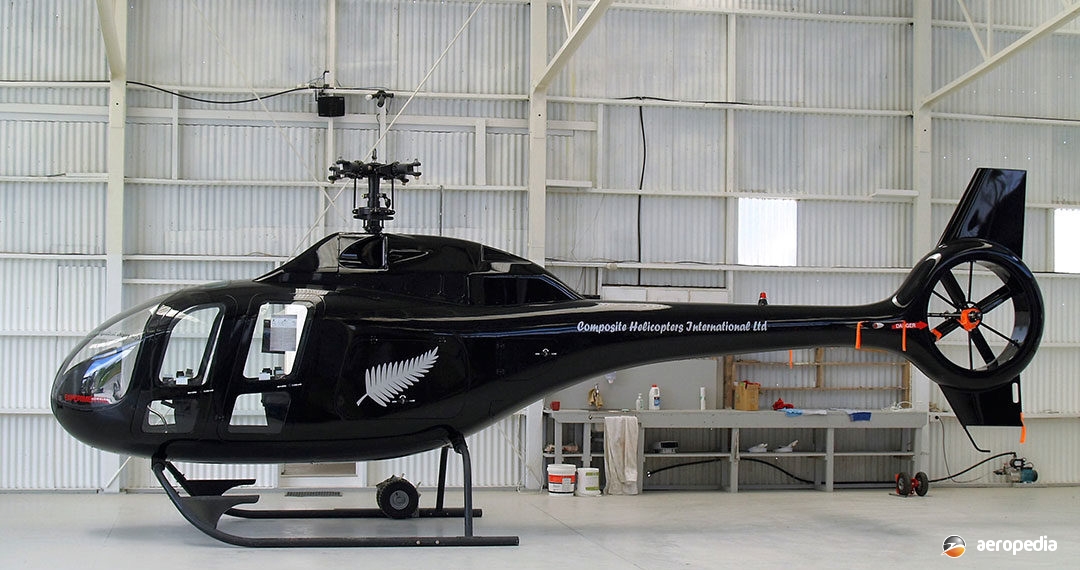Photograph:
Composite Helicopters KC-518 Adventurer (c/n 2) nearing completion at Hamilton, NZ (David Bates)
Country of origin:
New Zealand
Description:
Five / six-seat utility helicopter
Power Plant:
One 238 kw (320 hp) Rolls Royce 250 T63-700 turboprop
Specifications:
- Cruising speed: 250 km/h (155 mph)
- Service ceiling: 4,267 m (14,000 ft)
- Rate of climb: 305 m/min (1,000 ft/min)
- Endurance: 3.6 hours
- Baggage capacity: 1.01 m³ (36 cub ft)
- Fuel capacity: 533.6 litres (117 Imp gals)
- Useful load: 658 kg (1,450 lb)
- Loaded weight: 1,452 kg (3,200 lb)
History:
The Composite Helicopters KC-518 Adventurer was a five or six-seat utility helicopter aimed at the amateur-built market. It was available as a kit-built light helicopter of advanced design featuring fibreglass and Kevlar composite construction. The primary fuselage consisted of 33 parts that the constructor assembled using glues and layers of carbon cloth and resin. All parts were prefabricated and no welding or riveting was required.
A proof of concept mock-up was taken to the United States and placed on display at the 2011 Experimental Aircraft Association event at Oshkosh in Wisconsin where it met favourable interest and a number of deposits were received from buyers.
The Company described the fuselage shell as being Monologue, there being no frame around which the helicopter was built. The design and construction technique created a simple and easy to build helicopter. The primary parts were manufactured by using both infusion and an RTM process. The fuselage shell was built from the outside in. It was assembled in a specific order, all bulkheads, keel beams, floor panels and sub-assembly parts being inserted into the fuselage through the cabin doors.
All internal parts were trimmed to fit at specific locations and there were numerous datum references which dictated part location. Riveted anchor nuts were used to secure external cowlings in place and the MRGB engine and TRGB pressurised frames were bolted-in structures. The flight control system, drive-train and rotor systems were similar to those used on certified turbine helicopters from other manufacturers. The basic electrical system was a modern design incorporating large gauge primary leads ensuring good starting currents for the turbine.
The machine featured a four-blade aluminium main rotor and a shrouded composite tail rotor. The Company offered the machine as a kit, with a fast-build option, and proposed to offer a certified production model.
The first two production machines were approved by the New Zealand Civil Aviation Authority (CAA) to be built in the Company’s facility and to have their experiences documented in the assembly manual. The noise signature was described as low, the main rotor speed being 380 rpm with a rotor tip speed of 178 m/min (585 ft/min). Air conditioning was available, with the left cowl accommodating the condenser and pump. There were four lockers for stowage, with a capacity of 1.11 m³ / 299 kg (39.5 ft³ / 660 lbs). The fuel system comprised 1, 2, 3 or 4 composite tanks with a total capacity of 507 litres (111.5 Imp gals).
The helicopter was produced in New Zealand and was designed for speed with power, agility, ruggedness and endurance to match. Engine options included the Rolls Royce RR-250C18/T63, the Rolls Royce RR-250C20B, and a future option, the Rolls Royce RR-500 de-rated to 336 kw (450 shp).
The aircraft was designed to FAR Part 27 at 1,452 kg (3200 lb) gross weight, with a VNE of 160 knots (296 km/h / 184 mph). The engine and main rotor gear installation was chrome-moly and was attached to the main keel beam.
The prototype was fitted with a Rolls Royce RR-250C/T63 engine driving a four-blade main rotor and a four-blade tail rotor. Cruising at 250 km/h (155 mph) it had an endurance of six hours with an extended range tank, but was typically 3.5 hours.
Registered as a Helipod KC-518, the prototype ZK-ICM (c/n 1) was registered to Composite Helicopters MFG Ltd of Albany on 30 September 2011. By early 2013 a further two examples had been completed (c/ns 2 and 3) and production has continued to meet orders. However, on 7 May 2013 ZK-ICM ditched in Auckland Harbour off North Head due to an engine problem and was recovered.
Development of the series has continued and on 28 November 2013 an example became ZK-HOL (c/n 003) registered to Composite Helicopters of Albany.

